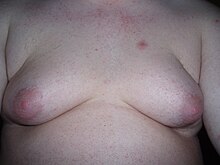User:Mr. Ibrahem/Gynecomastia
| Gynecomastia | |
|---|---|
| Other names | Gynaecomastia |
 | |
| A young adult male with gynecomastia | |
| Pronunciation | |
| Specialty | Endocrinology, plastic surgery |
| Symptoms | Enlargement of one or both breasts[3] |
| Usual onset | Any age[3] |
| Duration | Months to years[3] |
| Causes | Physiologic, obesity, liver disease, kidney failure, certain cancers, thyroid disease, medications, recreationally drugs, malnutrition[3] |
| Differential diagnosis | Pseudogynaecomastia, breast cancer, dermoid cyst[4][3] |
| Treatment | Reassurance, addressing the underlying cause, medications, surgery[5] |
| Medication | Tamoxifen, clomiphene[3] |
| Frequency | Common[4] |
Gynecomastia is the non-cancerous enlargement of one or both breasts in men.[3][6] Some only use the term when enlargement is due to glandular tissue and use the term pseudogynaecomastia when enlargement is the result of excessive fat tissue.[5][6] Occasionally tenderness may be present.[4] The condition can result in psychological distress.[6]
Gynecomastia can be normal in newborns due to exposure to estrogen from the mother, during puberty, and in older men.[3] These cases do not generally require further investigations.[5] It can also be associated with obesity, liver disease, kidney failure, certain cancers, thyroid disease, certain medications and recreational drugs, Klinefelter syndrome, and malnutrition.[3] The underlying mechanism often involves increased estrogen or decreased androgen levels.[4]
Cases that occur in puberty generally resolve within two years and require only simple reassurance.[5][7] The condition also commonly resolves if the underlying cause is addressed.[5] Medications such as tamoxifens or clomiphene are effective when used early.[3] In long standing cases surgery, such as liposuction or surgical excision, is the only effective option.[5]
Gynecomastia affects about 35% of men and is most common between the ages of 50 and 69.[5] It is present in up to 90% of newborns and 60% of boys during puberty.[6] It is the most common reason males seek medical care for a breast issue.[8] Description of the condition date from 2nd century by Galen.[8]
References[edit]
- ^ "Gynaecomastia | Definition of Gynaecomastia by Oxford Dictionary on Lexico.com". Lexico Dictionaries | English. OxfordDictionaries.com. Archived from the original on 8 March 2021. Retrieved 17 November 2020.
- ^ "Definition of Gynecomastia". www.merriam-webster.com. Archived from the original on 9 March 2021. Retrieved 17 November 2020.
- ^ a b c d e f g h i j Vandeven, HA; Pensler, JM (January 2020). "Gynecomastia". PMID 28613563.
{{cite journal}}: Cite journal requires|journal=(help) - ^ a b c d Narula, H. S.; Carlson, H. E. (August 2014). "Gynaecomastia-pathophysiology, diagnosis and treatment". Nature Reviews Endocrinology. 10 (11): 684–698. doi:10.1038/nrendo.2014.139. PMID 25112235. S2CID 40159424. Archived from the original on 4 December 2020. Retrieved 29 November 2020.
- ^ a b c d e f g Thiruchelvam, Paul; Walker, Jonathan Neil; Rose, Katy; Lewis, Jacqueline; Al-Mufti, Ragheed (22 September 2016). "Gynaecomastia". British Medical Journal. 354: i4833. doi:10.1136/bmj.i4833. ISSN 1756-1833. PMID 27659195. S2CID 220098795. Archived from the original on 1 March 2021. Retrieved 29 November 2020.
- ^ a b c d Niewoehner, CB; Schorer, AE (March 2008). "Gynaecomastia and breast cancer in men". British Medical Journal. 336 (7646): 709–713. doi:10.1136/bmj.39511.493391.BE. PMC 2276281. PMID 18369226.
- ^ Shulman, DI; Francis, GL; Palmert, MR; Eugster, EA; Lawson Wilkins Pediatric Endocrine Society Drug and Therapeutics Committee (April 2008). "Use of aromatase inhibitors in children and adolescents with disorders of growth and adolescent development". Pediatrics. 121 (4): e975–983. doi:10.1542/peds.2007-2081. PMID 18381525. S2CID 39852740. Archived from the original on 28 September 2018. Retrieved 29 November 2020.
- ^ a b Shiffman, Melvin A. (2018). Nipple-Areolar Complex Reconstruction: Principles and Clinical Techniques. Springer. p. 245. ISBN 978-3-319-60925-6. Archived from the original on 28 August 2021. Retrieved 30 November 2020.
